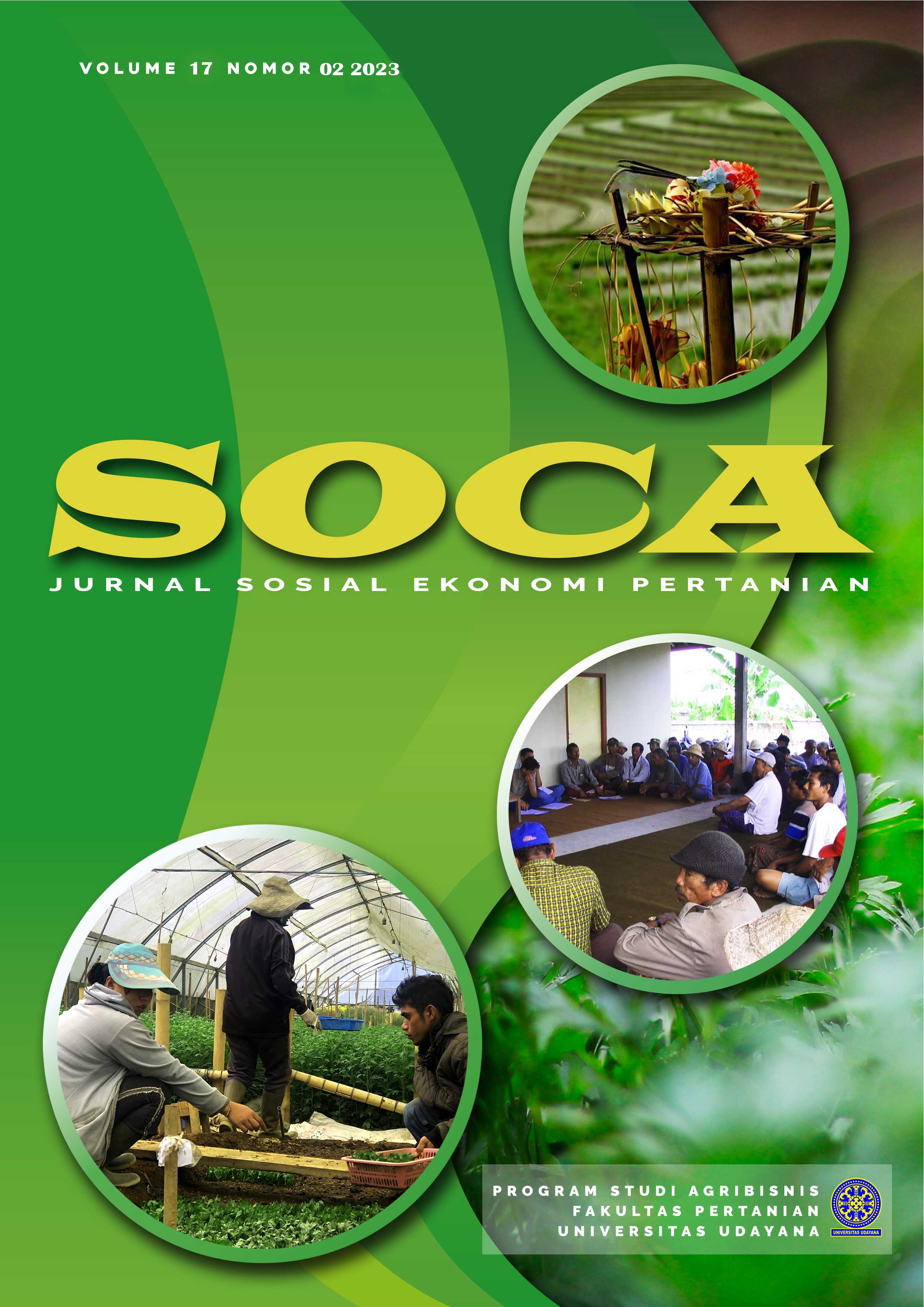Diversity of Home Garden Plants in Traditional Tourism Villages
Abstract
Socio-cultural shifts and environmental changes can cause changes in the composition of plants in the home garden. These changes may lead to the loss of uniquely valuable plants in the home garden. Therefore, this study aims to identify species and functions; diversity and similarity as well as the composition of home garden plants in three traditional Balinese tourism villages. The method used was a survey with observation data collection techniques, questionnaires, and interviews. There were a total of 90 samples of home gardens from three traditional tourism villages in Bali with different landscape characteristics, namely Tenganan Pegringsingan, Pengotan, and Julah villages. They were selected as survey locations to record plant diversity. The results of this study show that the plants in the home gardens of the three villages have the main function as ornaments plants. Plants in both Tenganan Pegringsingan and Julah Villages have a high diversity of species, while those in Penggotan Village are considered as the medium category. The differences in plant species in each location indicate that the owners’ culture also has an influence in addition to environmental factors
Downloads
References
Avilez-López, T., Van Der Wal, H., Aldasoro-Maya, E. M., & Rodríguez-Robles, U. (2020). Home gardens’ agrobiodiversity and owners’ knowledge of their ecological, economic and socio-cultural multifunctionality: A case study in the lowlands of Tabasco, México. Journal of Ethnobiology and Ethnomedicine, 16(1), 1–13. https://doi.org/10.1186/s13002-020-00392-2
Behbahani, A. G., Khoshbakht, K., Davari, A., Tabrizi, L., Veisi, H., & Alipour, A. (2012). Assessing the effect of socio-economic factors on agrobiodiversity in homegardens of Jajrood and jamabrood in Tehran province(Iran). Advances in Environmental Biology, 6(5), 1708–1715.
Berkowitz, B. N., & Medley, K. E. (2017). Home gardenscapes as sustainable landscape management on St. Eustatius, Dutch Caribbean. Sustainability (Switzerland), 9(8). https://doi.org/10.3390/su9081310
Brown, K. A., Parks, K. E., Bethell, C. A., Johnson, S. E., & Mulligan, M. (2015). Predicting plant diversity patterns in madagascar: Understanding the effects of climate and land cover change in a biodiversity hotspot. PLoS ONE, 10(4), 1–19. https://doi.org/10.1371/journal.pone.0122721
Elih Nurlaelih, E., Hakim, L., Rachmansyah, A., & Antariksa, A. (2019). Landscape Services Of Home Garden For Rural Household: A Case Study Of Jenggolo Village Malang Regency. Agricultural Social Economic Journal, 19(3), 135–143. https://doi.org/10.21776/ub.agrise.2019.019.3.2
Fuentes, T. L. (2021). Homeowner preferences drive lawn care practices and species diversity patterns in new lawn floras. Journal of Urban Ecology, 7(1), 1–13. https://doi.org/10.1093/jue/juab015
Gbedomon, R. C., Fandohan, A. B., Salako, V. K., Idohou, A. F. R., Kakaï, R. G., & Assogbadjo, A. E. (2015). Factors affecting home gardens ownership, diversity and structure: A case study from Benin. Journal of Ethnobiology and Ethnomedicine, 11(1). https://doi.org/10.1186/s13002-015-0041-3
Hakim., L. (2014). Etnobotani dan Manajemen Kebun-Pekarangan Rumah: Etnobotani dan Manajemen Kebun-Pekarangan Rumah: Ketahanan Pangan, Kesehatan dan Agrowisata. Retrieved from https://biologi.ub.ac.id/wp-content/uploads/2015/11/ETNOBOTANI-dan-MANAJEMEN-KEBUN-PEKARANGAN-RUMAH.pdf
Iskandar, J., Iskandar, B. S., & Partasasmita, R. (2018). Review: The impact of social and economic change on domesticated plant diversity with special reference to wet rice field and home-garden farming of West Java, Indonesia. Biodiversitas, 19(2), 565–577. https://doi.org/10.13057/biodiv/d190227
Jegora, T., Asfaw, Z., & Anjulo, A. (2019). Woody Species Diversity and Management in Homegarden Agroforestry: The Case of Shashemene District, Ethiopia. International Journal of Forestry Research, 2019. https://doi.org/10.1155/2019/3697047
Kazakis, G., Ghosn, D., Remoundou, I., Nyktas, P., Talias, M. A., & Vogiatzakis, I. N. (2021). Altitudinal vascular plant richness and climate change in the alpine zone of the lefka ori, crete. Diversity, 13(1), 1–16. https://doi.org/10.3390/d13010022
Khuswati, R., & Pudjiastuti, A. Q. (2022). Sustainability of the Kawasan Rumah Pangan Lestari ( A Sustainable Food House Area Program ) in Pasuruan Regency. 16(1), 28–41.
Magurran, A. E. (2004). Measuring Biological Diversity. In Angewandte Chemie International Edition, 6(11), 951–952.
Mohan, S., Ramachandran Nair, P. K., & Long, A. J. (2007). An assessment of ecological diversity in homegardens a case study from Kerala state, India. Journal of Sustainable Agriculture, 29(4), 135–153. https://doi.org/10.1300/J064v29n04_10
Nurjani, N. P. S. (2016). Struktur Rumah Tinggal Masyarakat Julah. Jurnal Arsitektur, Bangunan, & Lingkungan, 5(2), 91–104.
Prihatini, J., Iskandar, J., & Partasasmita, R. (2018). Struktur Pekarangan Komersil: Studi Kasus Di Desa Sukapura Kecamatan Kertasari Kabupaten Bandung, Das Citarum Hulu, Jawa Barat, Indonesia. BIOTIKA Jurnal Ilmiah Biologi, 16(2), 5. https://doi.org/10.24198/bjib.v16i2.19904
Regassa. (2016). Useful plant species diversity in homegardens and its contribution to household food security in Hawassa city, Ethiopia. African Journal of Plant Science, 10(10), 211–233. https://doi.org/10.5897/ajps2016.1439
Sari, I. D., Yuniar, Y., Siahaan, S., Riswati, & Syaripuddin, M. (2015). Community Tradition in Planting and Using Medicinal Plant in Surround Home Yard. Indonesian Pharmaceutical Journal, 5(2), 123–132. Retrieved from http://download.portalgaruda.org/article.php?article=378944&val=4889&title=Tradisi Masyarakat dalam Penanaman dan Pemanfaatan Tumbuhan Obat Lekat di Pekarangan
Sudarma, I M. & As-syakur, A. R. (2018). Dampak perubahan iklim terhadap sektor pertanian di provinsi bali. SOCA, 12(1). https://doi.org/https://doi.org/10.24843/SOCA.2018.v12.i01.p07
Soni, D. K., & Ansari, F. (2017). Climate change and biodiversity; impacts, vulnerability and mitigation in Indian perspective : A review. Journal of Applied and Natural Science, 9(1), 632–638. https://doi.org/10.31018/jans.v9i1.1243
Sujarwo, W., & Caneva, G. (2015). Ethnobotanical study of cultivated plants in home gardens of traditional villages in Bali (Indonesia). Human Ecology, 43(5), 769–778. https://doi.org/10.1007/s10745-015-9775-8
Surat, H., & Yaman, Y. K. (2017). Konut bahçelerindeki bitki türlerinin değerlendirilmesi: Batum (Acara) kent merkezi örneği. Turkish Journal of Forestry | Türkiye Ormancılık Dergisi, 18(1), 11–11. https://doi.org/10.18182/tjf.308755
Umbu, Y., Sabaora, O., Priyanto, S. H., & Prihtanti, T. M. (2021). The Food Security Of The Household Recipient Of Food Independent Village Program In Central Sumba Regency. 15(2), 334–344.
Wakhidah, A. Z., Chikmawati, T., & Purwanto, Y. (2020). Homegarden ethnobotany of two saibatin villages in lampung, indonesia: Species diversity, uses, and values. Forest and Society, 4(2), 338–357. https://doi.org/10.24259/fs.v4i2.9720
Wijaya, I. K. M. (2019). Konsepsi Natah Dan Lebuh Sebagai “Ruang Keseimbangan” Dalam Arsitektur Tradisional Bali. Jurnal Arsitektur ZONASI, 2(2), 98. https://doi.org/10.17509/jaz.v2i2.14677
Wiranatha, I. K., Dharmadiatmika, I. M. A., & Krisnandika, A.A. K. (2021). Model Desain Taman Toga Desa Bukian, Kecamatan Payangan, Kabupaten Gianyar. Jurnal Lanskap Indonesia, 13(2), 45–53. https://doi.org/10.29244/jli.v13i2.34321













